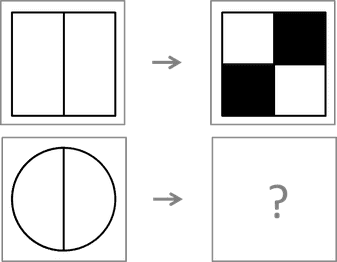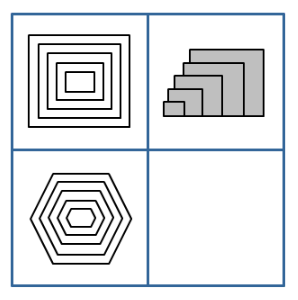The CogAT marks a key milestone as students transition across grade levels and face tests that measure reasoning and not learned facts. It’s a multi-level, battery-based assessment (Verbal, Quantitative, Nonverbal) that is often used for screening, placement, and growth measurement. From my years of experience creating CogAT-style materials, I know what drives success. I’m Roni, the CogAT specialist at TestPrep-Online.
If you’re looking to help your child or student prepare effectively for the CogAT, this page is the perfect starting point. Here, you’ll find:
- Free sample questions across Verbal, Quantitative, and Nonverbal batteries for kindergarten to Grade 6
- Clear, grade-mapped explanation of format, timing, and skills
- Guidance on understanding CogAT scores and reports
- Prep tips and FAQs to simplify CogAT prep planning
Click on the link below to view free CogAT–style questions for your child’s grade.
Kindergarten | 1st Grade | 2nd Grade | 3rd Grade | 4th Grade | 5th Grade | 6th Grade
Open the page content below to discover everything you need to know about the CogAT test. Our page offers general information along with sample questions to get you started.
Free CogAT Sample Questions
The CogAT is a fast-paced reasoning test built around three timed “batteries”, Verbal, Quantitative, and Nonverbal. Each battery is broken into short subtests where students often have less than a minute per question, making time management just as important as skill. Altogether, the exam takes roughly 90 minutes to 2–3 hours, depending on grade level and proctor pacing. Below, you’ll find sample questions by grade to show what this format looks like in action.
Free CogAT Kindergarten Sample Questions
Free CogAT 1st Grade Sample Questions
Free CogAT 2nd Grade Sample Questions
Free CogAT 3rd Grade Sample Questions
Free CogAT 4th Grade Sample Questions
Free CogAT 5th Grade Sample Questions
Free CogAT 6th Grade Sample Questions
Understanding Your Child’s CogAT Scores
The CogAT shows how your child reasons and solves problems in Verbal, Quantitative, and Nonverbal areas. Here’s what each score means:
- Raw Score: Number of questions answered correctly.
- Universal Scale Score (USS): A standardized score for each battery.
- Standard Age Score (SAS): Ranges from 100 (average) to 160 (very advanced).
- Percentile Rank (PR): Shows how your child compares to same-age peers (e.g., PR 80 means higher than 80 percent of students).
- Stanine (1–9): A broad ability band, with 5 as average and 9 as very high.
For a full parent guide with examples, visit our CogAT score explanation page
How Can Parents Help Students Prepare ?
Effective CogAT prep focuses on building reasoning habits, not teaching test tricks. Here are four practical tips:
- Daily short practice sessions: 5–25 minutes of mixed battery practice improves pattern recognition.
- Explain reasoning aloud: Ask your child to say why they picked an answer to strengthen reasoning pathways.
- Focus on unfamiliar formats: Paper folding and matrices often surprise students, so use hands-on practice.
- Build stamina gently: Practice with timed mini sessions ahead of the full test day.
CogAT Question Types Explained
Verbal Battery Question Types
The Verbal Battery evaluates how well students understand and manipulate language. Common CogAT verbal question types include verbal analogies, sentence completion, and verbal classification. Younger students may work with pictures, while older students respond to written words and sentences. These questions measure reasoning, not vocabulary memorization, which is why familiarity with the format is key.
Quantitative Battery Question Types
The Quantitative Battery focuses on number relationships and mathematical reasoning rather than calculation. Students may see number analogies, number series, or quantitative classifications. Calculators are not allowed, and questions are designed to test logic and pattern recognition, not advanced math knowledge.
Nonverbal Battery Question Types
The Nonverbal Battery uses shapes, figures, and visual patterns to assess abstract reasoning. Common question types include figure matrices and figure analogies. Because no reading is required, this battery is often considered the fairest measure for English language learners
Preparing Your Child for CogAT Success: What’s in Our PrepPack
Our CogAT PrepPack is built for every grade band and built with intention. Each activity follows a smart, sequenced progression that mirrors the official CogAT batteries, so students aren’t just practicing; they’re actually thinking better. This isn’t about rote memory. It’s about strengthening the core reasoning skills that drive success in school and beyond.
Parents tell us the PrepPack gives them something priceless: clarity. Instead of guessing what to practice or hoping their child is “ready,” you get a proven roadmap that helps your child walk into test day calm, prepared, and confident.
What’s Included:
- Full-Length CogAT-Style Practice Tests for Every Grade Band
Realistic timing. Authentic question types. A true representation of what your child will face. These tests reveal where your child shines and where they need support — and they make every study session count. - Parent-Friendly Study Guide
You don’t need a background in education to help your child succeed. Our guides break down each battery in straightforward language and give you a clear step-by-step plan. Think of it as having an expert tutor in your corner, showing you exactly what to do next. - Expert Tutor Tips & Worked Examples
We model the thinking process behind each question so students learn how strong problem-solvers approach challenges. This builds strategy, speed, and real cognitive flexibility. - Simple Progress Tracking Tools
No overwhelm. No complicated charts. Just clear data that helps you see growth, celebrate wins, and keep your child on track.
Ask Roni

An educational technology expert with a background in Physics and Astronomy and over nine years of experience designing AI-enhanced assessment materials that mirror real digital testing environments. Roni creates prep packs with clear, thoughtfully structured practice that strengthen understanding, build confidence with edtech tools, and empower every learner to succeed in an evolving digital landscape.
CogAT Test Prep FAQs
The CogAT measures reasoning skills in three areas: Verbal, Quantitative (math-based reasoning), and Nonverbal (visual–spatial problem solving).
More than Practice Tests
Practice Tests, Video Tutorials, Study Guides, Additional Drills, Expert Explanations
Realistic Simulations
PrepPacks tailored to accurate test scenarios.
Interactive Tests
Practice materials, designed to help students perform their best on their tests!
Premium Quality
Expert-crafted practice tests with accurate questions and explanations
Most U.S. school districts now administer CogAT Form 8 as their standard assessment. Some parents may still hear references to Form 7, especially in older documentation, but Form 8 is the version currently supported, normed, and recommended by the test publisher.
No. It measures how students think and learn, not overall intelligence. It focuses on patterns, relationships, and logic.
Students complete three batteries—Verbal, Quantitative, and Nonverbal—each made up of three short subtests. Younger grades use pictures; older grades use words and numbers.
No. K–2 tasks rely mostly on pictures and oral directions. Grades 3+ use reading, number reasoning, and more complex problem-solving. Difficulty arises with age.
Practice with sample questions and simulated test conditions helps, as does building familiarity with test sections; formal tutoring is less critical at earlier grades.
Most commonly in the fall or spring, varying by school district.















